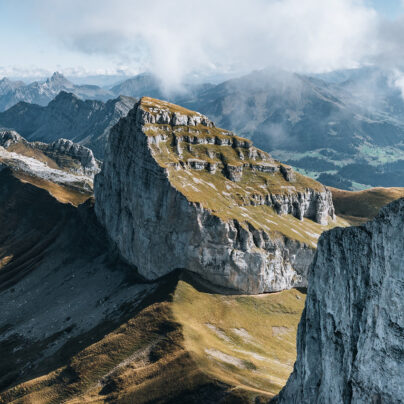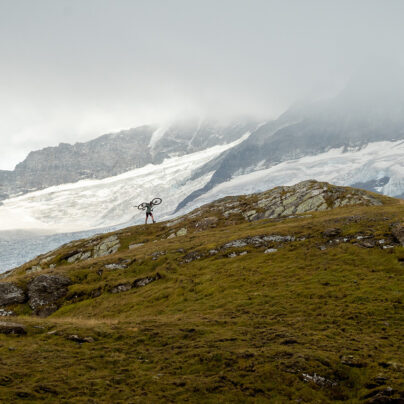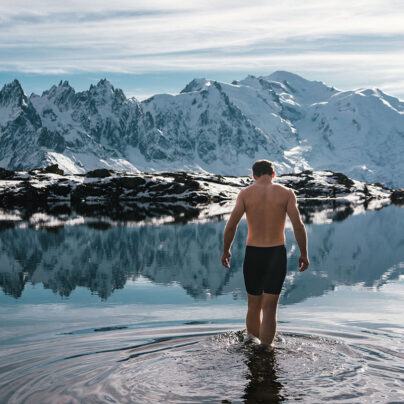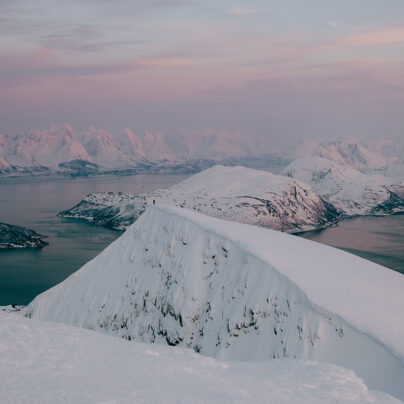Reconnection Through Altruism
Finding wellbeing while protecting our natural and wild places through Trash Free Trails
Written by Tom Hill // Photography by Sam Needham
Produced in Partnership with Trash Free Trails & Komoot
‘The pollution of our trails is having a negative effect on our mental health. The very places that millions of us visit to clear our heads, feel better about the world, escape the stress and strains of life are not only being failed, they are failing to have the positive impact we need because of our lack of care.’
I stand below the huge pylon that marks the approximate centre, and high point, of Dawson Wood. My eye line is drawn along the cables, through a window of clearfell to the Aire Valley below and Baildon Moor beyond. Early morning light catches the neon purple of blooming heather in the distance. On my left is a small patch of pine plantation and to my right lies native woodland criss-crossed with paths and tracks. A gentle breeze chills my sweat-dampened back and whistles through the metalwork above my head. The trees either side of me sway, and the squawks of a sparrowhawk are carried across to me before being whipped north into the Yorkshire Dales.
I turn to look down the trail and ready myself to break back into a run, but I realise that I am face to face with a roe deer. I’m not sure which of us is more startled; we’ve seen each other before, but never this close. After what feels like an age the deer leaps to the side of the trail and out of sight. I am stunned by the closeness of this encounter with nature. It leaves me with a deep feeling of connectedness to the world around me: more than that, I feel part of it. Nature is not just something to be observed passively; it is something that we are intrinsically a constituent part of.
Eventually, I do run again, skipping and hopping over the rocks in the trail with a sense of flow that only comes with familiarity. And then I am stopped in my tracks again. This time by something altogether less natural. Two energy drink bottles lie in the middle of the trail, their bright colours jarring in a way that the fluorescent heather never could. My sense of well-being flees more quickly than the deer, my bubble of joy in nature that I had been floating in instantly popped. The illusion of immersion in the wild has been exposed as just that. An illusion.



The reality is that barely a square metre of this tiny scrap of woodland hasn’t been shaped or influenced by humans’ hands or feet. While I find a brutalist beauty in the pylon – this huge metal tree standing, unmoving and watching over a forest that bows to the winds – it certainly is not natural. Neither is the view across clearfell that it affords. The moors in the distance only look the way they do thanks to centuries of land management. Even in the native woodland there are the pockmark hollows of small gritstone quarries, occasional remains of drystone walls, and stone gateposts marking an invisible entrance to a long-forgotten property boundary. In the adjoining woodland there are archaeological remains of a prehistoric enclosure: lumps and bumps of earthworks that only an educated eye would differentiate from the rest of the landscape. Set on the northern outskirts of Bradford, Dawson Wood is not wilderness. Even in its depths it is impossible to completely escape the hand of man in one way or another.
Yet within this small triangle hemmed in by road, railway (in fact a rail line runs directly underneath the ground I am standing on), and canal are countless varieties of trees, woodpeckers, foxes, badgers, herons, tawny owls, wild mushrooms, perfect carpets of bluebells, wild garlic, red kites, and of course the sparrowhawks and deer. It is a deeply special and important place, precisely because it isn’t the wilderness. It is a pocket of nature on the edge of the city. Its value isn’t just as a wildlife haven, but it is intrinsically linked to it.
On our busy, often crowded-feeling island, it is these accessible corners of woodland, park, moor, and other natural places that have been the saviours for many in the last two years. They have been a destination for daily exercise; a physical and mental escape from a world that has felt stressful and overwhelming. This phenomenon has been examined widely since the start of the pandemic, and research is beginning to show how important time outdoors is to our physical and mental well-being. A recent report recorded that 95 per cent of UK adults state that access to nature is important for their mental health.
Access to nature isn’t quite as simple as it might sound. The mantra of ‘Outside is Free’ forgets the position of privilege that many of us are in. Outside is only free if you can reach it quickly and easily. For large chunks of the population – particularly those who live in low-income areas of large cities – the mountains and wild places are utterly inaccessible. This may be literal or psychological inaccessibility; we do not yearn for what we don’t know. As a result, suburban and semi-rural green spaces are doubly important. They represent accessible time in nature, but also act as a gateway to further exploration.



My love for these places extends far beyond my own childhood of exploration – beyond even the joy and fun from having such a glorious parcel of land on my doorstep – and is founded in a recognition of its greater importance and value to the thousands of people that surround it.
Which is why my heart sinks when I find those Lucozade bottles on the trail. Dawson Wood suffers no less than many other places. I have never passed through without seeing at least one discarded dog-poo bag or sweet wrapper or drinks bottle. Perhaps today hurt a little more than others, the jarring contrast of the beauty of nature and ugliness of humanity’s disregard for it distilled into a few seconds. I find it impossible not to feel a small sense of sadness every time I pass a piece of trail pollution (for that is what this primarily single-use plastic waste is; a pollutant). I’m not the only one that feels this way either.
Trash Free Trails is a non-profit Community Interest Company, with a mission to remove 75 per cent of all litter on our trails and in our wild places by 2025. They plan to do this not just through trail cleans but also via finding ways to engender a reconnection between people and the outdoor places they visit. It’s worth dwelling on the second part of that sentence, because it is what hurts the most for me. Each and every piece of litter found on the trails has been left there by someone using that green space. It hasn’t been washed in by the tide; we are the tide.
I could spend the rest of this story trying to answer the question of why people litter. The short answer is that we don’t know, and ‘people’ are a collection of individuals so there are undoubtedly myriad reasons. My belief, and that of Trash Free Trails, is that for many there is a fundamental disconnection from nature. Their time outside is defined by what they did rather than what they experienced. Therefore, the desire to look after those places has been lost (or never engendered in the first place).
Regardless of the reasons why people litter, the result is that it is causing unknown environmental damage (TFT is researching exactly how much). Just as importantly, there are knock-on mental health effects for us, the users of those green spaces.
In the first report of its kind, Trash Free Trails’ ‘State of Our Trails Report – Baseline Study’ asked those who participated how seeing litter made them feel. The results were not exactly groundbreaking: they confirmed what we inherently know, and almost every respondent stated a state of sadness. The pollution of our trails is having a negative effect on our mental health. The very places that millions of us visit to clear our heads, feel better about the world, escape the stress and strains of life are not only being failed, they are failing to have the positive impact we need because of our lack of care. Fortunately, however, the situation is not as bleak as this statement may suggest.



I stoop down and pick up the bottles. I’ve taken to running with a small pack, even on my short runs. I stuff the bottles inside and set off again. The positive mood returns – is enhanced, even. Five seconds of my time have transformed my relationship with the trail.
One of the things that I love about trail running and mountain biking is the sense of interaction with the landscape it brings. Every footstep or line choice is judged, working with the terrain. The reality is that it is still a one-way relationship. I use the woods for fun, and then leave, thankful that they exist.
Picking up that pollution is an almost effortless way of giving something back to a place I love. Give and take in its simplest form. The woods, mountains, and fells give me pleasure; I take away something that doesn’t belong there. I feel a closer and truer connection with where I am, a sense of custodianship – not through a moral responsibility (although I personally feel that one exists) but through a simple desire to protect this land.
My experience isn’t unique. Acts of altruism are rarely completely altruistic; we feel good by doing something good. We, as a species, are hardwired to want to help. Acts of altruism actually strengthen those psychological connections in the brain. Altruism also promotes a sense of belonging to a wider community. It reduces our sense of isolation. Reassuringly, it is also contagious. The more we see others undertake altruistic acts, the more likely we are to as well. It’s good for us on an individual and societal level to help. Once again, virtually every respondent to TFT’s State of Our Trails survey reported similar feelings of pride, happiness, and closeness to nature as a direct result of conducting a trail clean. There have also been multiple anecdotal tales of passers-by joining in organised clean-ups, or simply being inspired to emulate the act at another time.
***
There have been times in my life, long before COVID (although they have certainly returned over the last couple of years) when I have felt utterly at sea in the wider world. Cast adrift and at a loss to how I can make my way back. Everything about the world feels so big and overwhelming. I don’t know how to exist in it.
Before I set off on this run, I had been doomscrolling through news apps and Twitter in bed: frustrated, upset, angry, scared. I needed to disconnect from that world, find the one that I knew existed. Running did that, but the small act of picking up a bottle did more. It reconnected me to the real world. Reminded me that I am part of it, and that on the smallest of levels I can change it. I may not be able to cure viruses, end queues at food banks, or single-handedly halt climate change, but I can make a positive and real difference to the world on my doorstep. And as a result of taking care of what I love, I am taking care of myself in a way I didn’t know was possible a few short months ago. There is a renewed sense of purpose in my adventures outdoors, one that goes beyond trying to be faster or exploring further. Quite simply, it is founded on a sense of custodianship over the locations that bring me so much joy.
Tom Hill was inspired to undertake his first trail clean after hearing Trash Free Trails founder Dom Ferris speak at Kendal Mountain Festival. After interviewing Dom for Sidetracked in early 2020, he has taken a more active role working with the organisation and telling the stories of their progress.
If you want to retrace Tom’s run, which actually passes through four distinct woodlands on the northern edges of Bradford, you can find it on komoot here. Take the time to stop and look for wildlife and maybe think about bringing something to carry some litter home. For more guidance, the Trash Free Trails Do It Ourselves Tookit has information on best practice, where and how to report your findings, and how to organise a group trail clean.
Website: trashfreetrails.org // Instagram: @trashfreetrails
Website: komoot.com // @komoot
Written by Tom Hill // @24Tom
Photography by Sam Needham // @samneedham_photo








